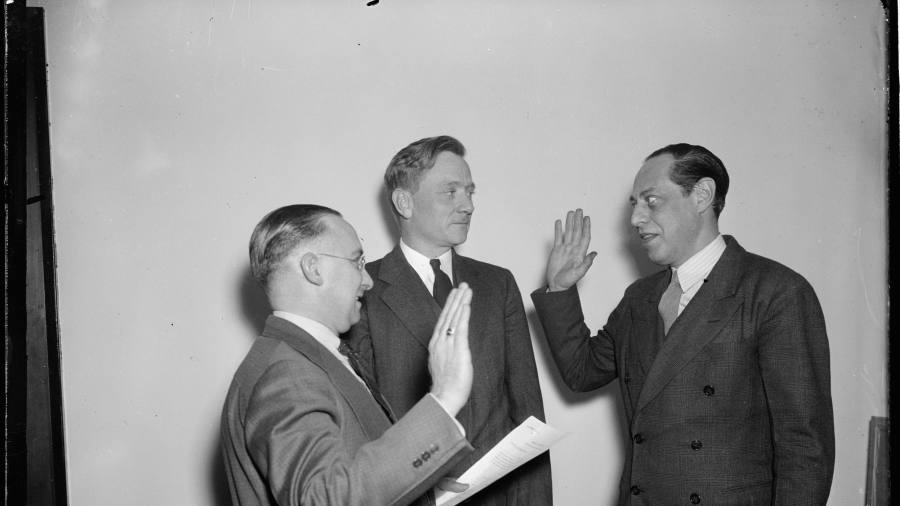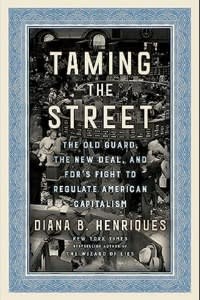
Receive free Non-Fiction updates
We’ll send you a myFT Daily Digest email rounding up the latest Non-Fiction news every morning.
The US Securities and Exchange Commission is very much in the news. Chair Gary Gensler recently made waves with an aggressive regulatory agenda that seeks to put a wide range of investment firms, from cryptocurrency exchanges to private equity funds, under much tighter supervision.
The financial industry is fighting back, claiming the SEC has overstepped and exceeded its statutory authority in ways that will ultimately harm investors. That makes Taming the Street, a new book by Diana B Henriques about the founding years of America’s primary securities regulator, particularly timely.
A former New York Times reporter, perhaps best known for The Wizard of Lies, her bestselling book about fraudster Bernard Madoff, Henriques has produced a lively tale that pits committed reformers against fat-cat insiders who feathered their own nests while fending off scrutiny.
This in-depth history of Wall Street and Washington from the late 1920s to the start of the second world war shows readers how and why the New Deal reformers of the 1930s believed that taming American finance was an essential part of pulling the country out of the Depression. It then follows the fledgling SEC as it gained the powers and wrote the rules that Gensler now wants to expand, while fighting off Wall Street criticism and recalcitrance.
Though regulatory history runs the risk of being technical and dry, Henriques neatly sidesteps this problem by anchoring her story in four larger-than-life personalities. President Franklin Delano Roosevelt pushed for the creation of the SEC; Joseph Kennedy, the buccaneering Irish-American businessman, served as its first chair; William O Douglas, a feisty progressive lawyer, led it to greater strengths; and Richard Whitney, the patrician New York Stock Exchange chair, fought regulation every step of the way.
The story opens with the most devastating stock market crash in US history, the October 1929 frenzy that destabilised banks and helped unleash the Depression. Henriques explores the people and abusive practices behind the speculative boom of the 1920s, and the weak responses of Whitney and a financial services industry more interested in protecting its own than in market integrity and investor protection.
While Herbert Hoover, US president at the time, remained captured by anti-regulatory forces, FDR made financial reform and spreading the benefits of capitalism more widely a centrepiece of his 1932 campaign. By the time he finally took office in March 1933, the situation was dire: widespread bank runs had forced the government to declare a four-day national banking holiday and the NYSE shut for only the third time in its history.
The author’s detailed research and colourful stories bring to life the dogged efforts of New Deal reformers to investigate the wrongdoing, and write laws and rules to prevent a repeat. She reminds readers of the hard-fought legislative and court battles behind much of the financial protections that investors take for granted today. Laws creating deposit insurance, national investor protection standards and the regulation of stock exchanges and brokers all passed in a two-year period and then faced bitter challenges in the federal courts.
Though Kennedy is better known as the founder of a political dynasty, Henriques tracks his critical role as a high-profile entrepreneur who helped make the fledgling SEC and the New Deal broadly more palatable to business at a time when it was under attack from conservatives.
But it was the SEC’s third chair, Douglas, aided inadvertently by Whitney, who really gave the agency its swagger and many of the teeth that allow it to help keep the markets clean today. Taming the Street tells the riveting story of how Whitney was secretly embezzling client money, and when Wall Street’s biggest names, including the House of Morgan, tried to cover up his crimes, they created an opening for Douglas to push through reforms.
Though the stories are nine decades old, they resonate today, as powerful financiers seek to convince both Congress and an increasingly conservative Supreme Court to crimp the SEC’s power and limit its ability to scrutinise their moneymaking activities.
“Lawmakers — and those who vote them into office — must come to their senses . . . Deregulation is the route that would carry today’s America straight back into the plutocrat’s paradise of the unregulated 1920s,” Henriques warns.
Taming the Street: The Old Guard, the New Deal, and FDR’s Fight to Regulate American Capitalism by Diana B Henriques Random House £25/$30, 480 pages
Brooke Masters is the FT’s US financial editor
Join our online book group on Facebook at FT Books Café
